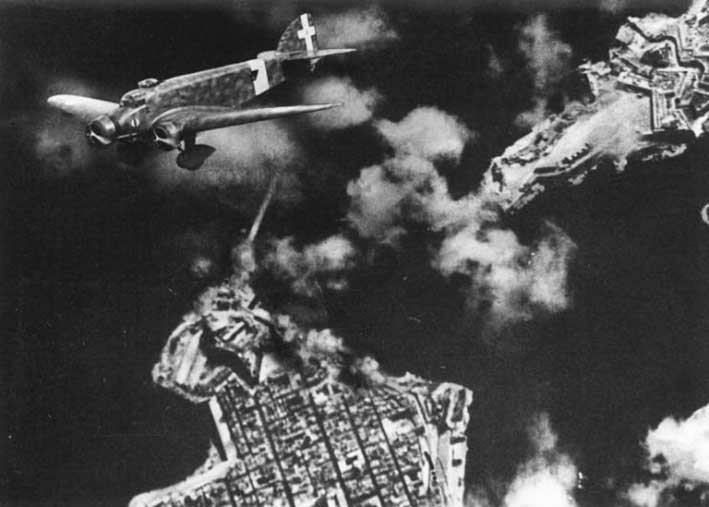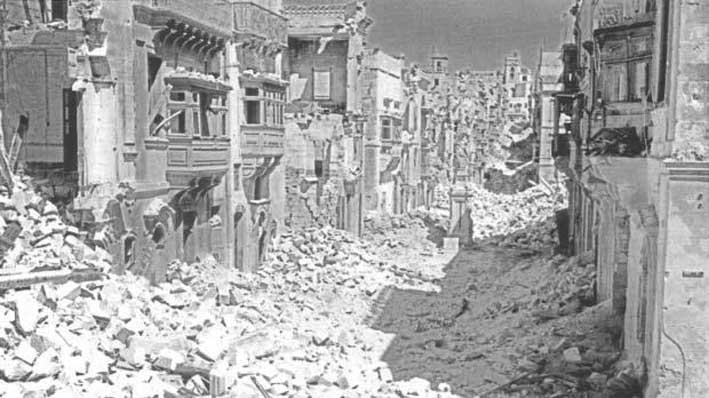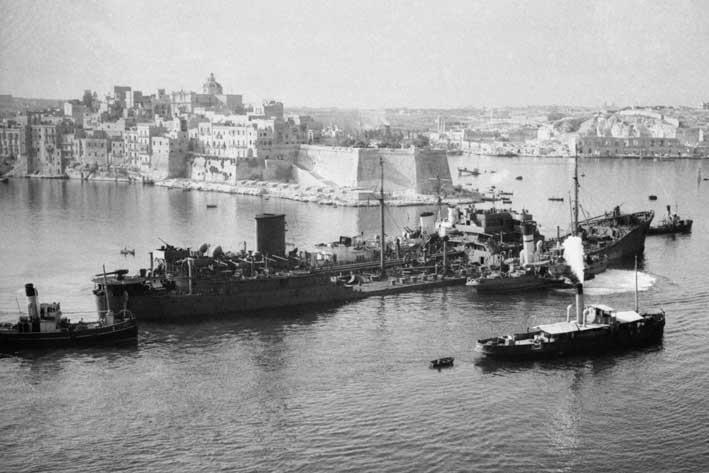270,000 Population of Malta and Gozo during the war.
1,581 Civilians killed as a result of enemy action.
3,780 People injured.
50,000 People made homeless as a result of enemy bombings. This equates to 18.5% of the total population.

7,500 Servicemen and merchant seamen killed on operations related to the Battle for Malta. This includes those lost at sea or shot down from the skies.
8 Air raids on the first day of bombings. The very first raid took place on 11th June 1940 at 6.55 am. The last alert was sounded in Malta just over 4 years later, on 28th August 1944 at 8.45 pm, and the last all-clear at 9 pm.

3,343 Total number of air raids recorded over Malta. 2,031 (60%) of these raids came in 1942 alone.
282 The largest amount of air raids in a single month came in April 1942, the worst month of the war for Malta, which saw the destruction of countless well-known landmarks, such as the Royal Opera House in Valletta, although scores of people were spared when a bomb which hit Mosta Church failed to explode.
2,357 Total hours spent by the Maltese under air-raids, equivalent to 98 days.

154 Successive days and nights under aerial attack in the Spring of 1942, meaning Malta holds the unenviable record for the heaviest, sustained bombing attack.
1 24-hour stretch without a single alert in the whole period of January to June 1942.
15,000 Tons of bombs dropped on the Maltese Islands, almost 4 times the amount of bombs dropped by the Allies in the notorious attack on Dresden in February 1945.
6,700 Tons of these bombs were dropped in just 1 month - April 1942.
10,761 Buildings destroyed, or extensively damaged and needing reconstruction. The vast majority were private dwellings.

20,000 Other private dwellings suffered damage and had to be repaired.
7,433 Unexploded bombs dealt with by the Royal Engineers. They were busiest in 1942, with 5,448 (73% of the total).

27 Allied warships or merchant vessels sunk by enemy bombing or mines in Malta's harbours or in the immediate vicinity.
42 Anti-aircraft guns to defend Malta in the first week of June 1940, as opposed to the 172 that had been recommended by the Committee of Imperial Defence in July 1939.
369 British fighter planes shot down while defending Malta from air attack. Another 64 were destroyed on the ground during bombing raids on the airfields.
532 Axis aircraft confirmed destroyed by the defenders. Of these, 357 belonged to the German Luftwaffe, and 175 to the Italian Regia Aeronautica.

241 Axis aircraft destroyed by anti-aircraft guns. Another 48 were listed as probably shot down but could not be confirmed.
102 Axis aircraft destroyed by Malta's anti-aircraft guns in just 1 month! This figure was reached in April 1942.

27 Axis aircraft shot down by Canadian pilot George Beurling in a period of only 14 flying days, making him the most successful Allied fighter pilot of the air battle for Malta.

390,660 - Tons of Axis shipping sunk by Malta-based submarines in the period of 1st January 1941 to 1st May 1942.

128,353 Tons of Axis shipping was sunk by just 1 submarine - HMS Upholder, the most successful of all British submarines. In 25 patrols while based at Malta, she sank 2 destroyers, 3 submarines, 3 troop transports, 10 supply ships, 2 tankers and 1 trawler.
8 U Class submarines from Malta were lost while on patrol, including HMS Upholder, lost with all hands on her 25th patrol, which was to have been her last before she returned to the UK.

17 Major convoy operations to Malta between 1940 and 1942.
65 Vessels formed part of the escort and support group for Operation Pedestal, making it the largest convoy operation ever undertaken up to that point. This consisted of 4 aircraft carriers, 2 battleships, 7 cruisers, 32 destroyers, 4 corvettes, 4 minesweepers, 8 submarines, 2 fleet oilers and 2 tug boats.
14 Merchant ships took part in Operation Pedestal. 9 of them were sunk, with only 5 reaching their destination - Malta's Grand Harbour.

32,000 Tons of supplies delivered by the surviving ships of Operation Pedestal, including around 10,000 tons of fuel brought in by the famous SS Ohio.

350 Approximate number of Royal Navy and Merchant Navy personnel killed during Operation Pedestal.
Matthew Camilleri is Tours Manager at Colour My Travel - [email protected]
www.colourmytravel.com
https://www.facebook.com/colourmytravel/